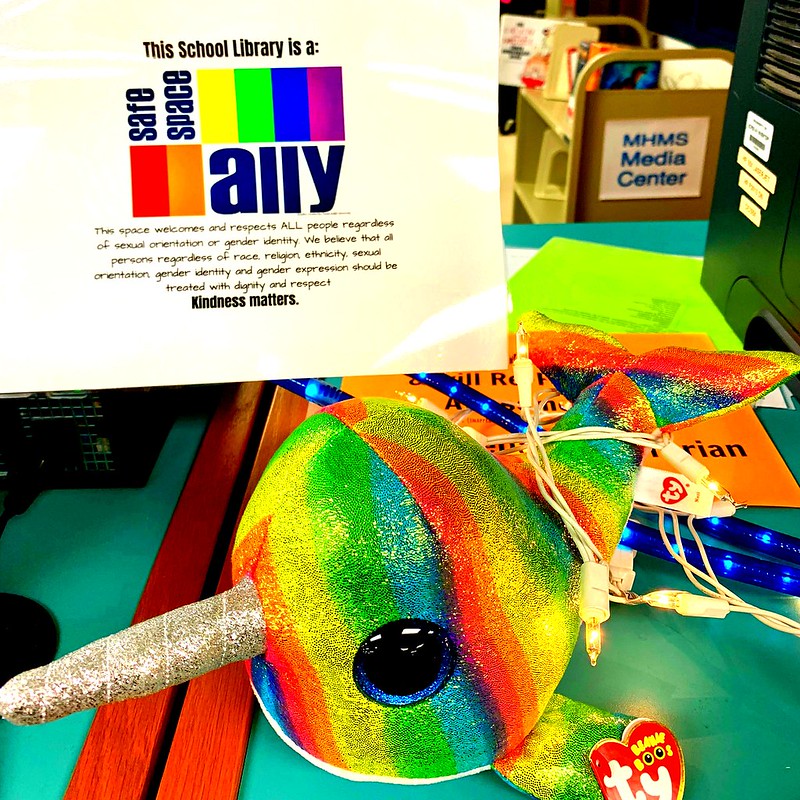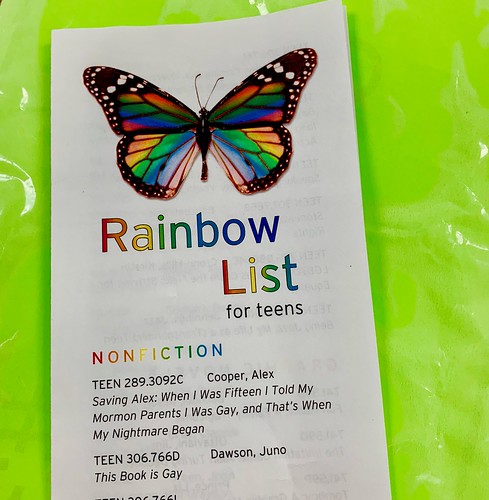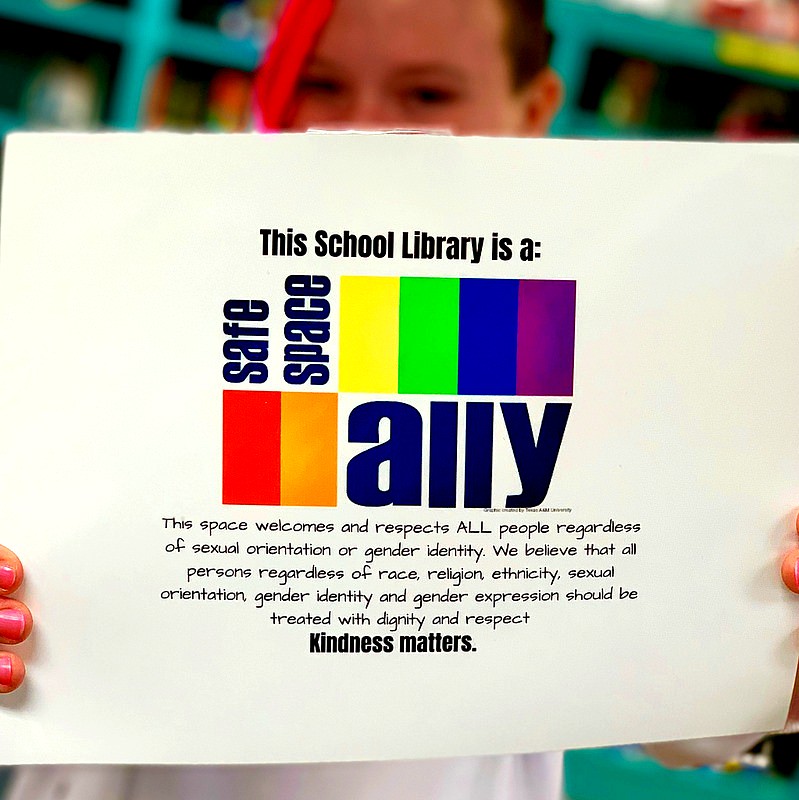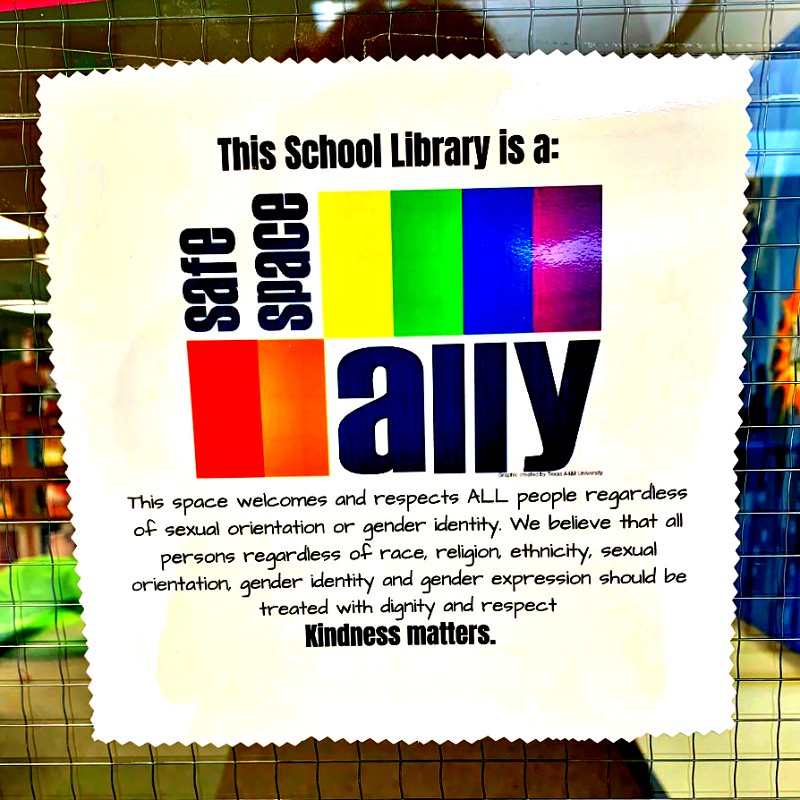Create a Safe Space
This is not something new. Our School Library has always been a safe space for kiddos of all kinds. Our wonderful Middle School community is a rich tapestry of many woven threads, rich colors, diverse backgrounds, orientations, expressions, many abilities and kids from many lands speaking many languages.
Laurel, Maryland is right smack dab between Washington DC and Baltimore - it's like our school has always been a mini United Nations. I love that about us! And our School Library has always enjoyed being a draw and a safe landing spot for kids who are quirky, nerdy, bookish, geeky, techie, queer, gay, trans, wordy, dramatic, creative, alternative, and cool.
That's why I thought it was important and reassuring to have a sign that proclaimed that we are a Safe Space or a Safe Zone right on our front doors and right by our check out desk!
What is a Safe Space? According to the Safe Space Network, “A Safe Space is a place where anyone can relax and be able to fully express, without fear of being made to feel uncomfortable, unwelcome, or unsafe on account of biological sex, race/ethnicity, sexual orientation, gender identity or expression, cultural background, religious affiliation, age or physical or mental ability.”
"K-12 schools have long served as a safe space for students. Whether a student is escaping abuse at home, discrimination due to sexuality or race, or overcoming trauma, teachers and schools regularly provide much more beyond academic learning. They also offer therapy, support, and a place of refuge for many, which makes learning possible. Looking at schools as safe, inclusive spaces helps prepare young people for our diverse world, giving them a sense of belonging and support so that they’re able to face life’s challenges in healthy ways." - Concordia - Portland University

The fact that I also found a rainbow narwhal with a glittery horn made it extra and spiffy!
SIDENOTE: Oh and, dear reader, though I maintain two blogs (this professional blog and my Daring School Library Edublog) I don't usually post the same things there that I do here...because that one is for my kids and the community and this one is hopefully a helpful blog journaling my professional tips, tricks, wins, fails, thoughts, and resources. But THIS post I felt was important enough to have both places. See?
What does it mean to be an Ally? What does it mean to have a Safe Zone or a Safe Space? I found a great resource from the Human Rights Campaign website:
"In the most general sense, an "Ally" is "a person who is a member of the dominant or majority group  who works to end oppression in their personal and professional life through support of, and as an advocate for, the oppressed population."
who works to end oppression in their personal and professional life through support of, and as an advocate for, the oppressed population."
Allies to racial, religious and ethnic minorities have been remarkably effective in promoting positive change in the dominant culture, and only recently has their instrumental position been extended to the area of sexual orientation.
In recent years we've seen more and more LGBTQ Ally organizations strive to make the culture of a campus or workplace more aware and accepting of gay, lesbian, bisexual, transgender and queer individuals
• be a listener
• be open-minded
• have their own opinions
• be willing to talk
• recognize their personal boundaries
• join others with a common purpose
• believe that all persons regardless of age, sex, race, religion, ethnicity, sexual orientation, gender identity and gender expression should be treated with dignity and respect
• recognize when to refer an individual to additional resources
• confront their own prejudices
• engage in the process of developing a culture free of homophobia, transphobia and heterosexism
• recognize their mistakes, but not use them as an excuse for inaction
• be responsible for empowering their role in a community, particularly as it relates to responding to homophobia or transphobia
• recognize the legal powers and privileges that cisgender straight people have and which LGBTQ people are denied
• support the Ally program of their university or workplace
• commit themselves to personal growth in spite of the discomfort it may sometimes cause As important as it is to define what an Ally is in a positive sense, it is also helpful to understand the boundaries of an Ally's role.
• necessarily a counselor, nor are they necessarily trained to deal with crisis situations"
Want this poster for your school library? Copy it from my GSuite Drive or download it from my Slideshare below!
One of my wonderful 8th graders told me about this super reading list available at the Howard County Public Library, and he brought me one! Sadly, they don't have the same list online, can't figure out why not (backlash?) How hard would it be to cut and paste it and put it online? I would share it with you here if it was available online, because it's a great list!
I Tweeted asking if it's available, the answer is below
Laurel, Maryland is right smack dab between Washington DC and Baltimore - it's like our school has always been a mini United Nations. I love that about us! And our School Library has always enjoyed being a draw and a safe landing spot for kids who are quirky, nerdy, bookish, geeky, techie, queer, gay, trans, wordy, dramatic, creative, alternative, and cool.
That's why I thought it was important and reassuring to have a sign that proclaimed that we are a Safe Space or a Safe Zone right on our front doors and right by our check out desk!
What is a Safe Space? According to the Safe Space Network, “A Safe Space is a place where anyone can relax and be able to fully express, without fear of being made to feel uncomfortable, unwelcome, or unsafe on account of biological sex, race/ethnicity, sexual orientation, gender identity or expression, cultural background, religious affiliation, age or physical or mental ability.”
"K-12 schools have long served as a safe space for students. Whether a student is escaping abuse at home, discrimination due to sexuality or race, or overcoming trauma, teachers and schools regularly provide much more beyond academic learning. They also offer therapy, support, and a place of refuge for many, which makes learning possible. Looking at schools as safe, inclusive spaces helps prepare young people for our diverse world, giving them a sense of belonging and support so that they’re able to face life’s challenges in healthy ways." - Concordia - Portland University

This space welcomes and respects ALL people regardless of sexual orientation or gender identity. We believe that all persons regardless of race, religion, ethnicity, sexual orientation, gender identity and gender expression should be treated with dignity and respect
Kindness matters.
The fact that I also found a rainbow narwhal with a glittery horn made it extra and spiffy!
SIDENOTE: Oh and, dear reader, though I maintain two blogs (this professional blog and my Daring School Library Edublog) I don't usually post the same things there that I do here...because that one is for my kids and the community and this one is hopefully a helpful blog journaling my professional tips, tricks, wins, fails, thoughts, and resources. But THIS post I felt was important enough to have both places. See?
What does it mean to be an Ally? What does it mean to have a Safe Zone or a Safe Space? I found a great resource from the Human Rights Campaign website:
What is an Ally?
 who works to end oppression in their personal and professional life through support of, and as an advocate for, the oppressed population."
who works to end oppression in their personal and professional life through support of, and as an advocate for, the oppressed population."Allies to racial, religious and ethnic minorities have been remarkably effective in promoting positive change in the dominant culture, and only recently has their instrumental position been extended to the area of sexual orientation.
In recent years we've seen more and more LGBTQ Ally organizations strive to make the culture of a campus or workplace more aware and accepting of gay, lesbian, bisexual, transgender and queer individuals
An Ally strives to...
• be a friend• be a listener
• be open-minded
• have their own opinions
• be willing to talk
• recognize their personal boundaries
• join others with a common purpose
• believe that all persons regardless of age, sex, race, religion, ethnicity, sexual orientation, gender identity and gender expression should be treated with dignity and respect
• recognize when to refer an individual to additional resources
• confront their own prejudices
• engage in the process of developing a culture free of homophobia, transphobia and heterosexism
• recognize their mistakes, but not use them as an excuse for inaction
• be responsible for empowering their role in a community, particularly as it relates to responding to homophobia or transphobia
• recognize the legal powers and privileges that cisgender straight people have and which LGBTQ people are denied
• support the Ally program of their university or workplace
• commit themselves to personal growth in spite of the discomfort it may sometimes cause As important as it is to define what an Ally is in a positive sense, it is also helpful to understand the boundaries of an Ally's role.
An Ally is NOT...
• someone with ready-made answers• necessarily a counselor, nor are they necessarily trained to deal with crisis situations"
Want this poster for your school library? Copy it from my GSuite Drive or download it from my Slideshare below!
One of my wonderful 8th graders told me about this super reading list available at the Howard County Public Library, and he brought me one! Sadly, they don't have the same list online, can't figure out why not (backlash?) How hard would it be to cut and paste it and put it online? I would share it with you here if it was available online, because it's a great list!
I Tweeted asking if it's available, the answer is below
Unfortunately, not at this time.— HowardCountyLibrary (@HoCo_Library) October 24, 2018



Hi Gwyneth! This is my first time checking out your blog and I love it! As a student in a Teacher-Librarian course, there are so many amazing resources here. I particularly enjoyed this post. I agree that school libraries have long been safe spaces for many students (geeky, techy, etc) and it's great that libraries are now reminding students of the importance of being an ally to LGBT students. I have long considered myself and ally and try to lead by example at school. I have a close and visible friendship with a non-binary teacher at my school, and I hope that when students see this, they can feel comfortable being allies too.
ReplyDeleteHey there, Anon.Thanks so much for your thoughtful comment. It means a lot to support all our kids and school team members -you're making a difference! I think we both believe that schools should be a safe place to be their authentic selves. Keep being awesome! If you ever want to contact me my email is on the contact me page of this blog - or you can connect via Twitter & Instagram - I'd love to part of your PLN! Just reference this comment so I know it's you! Cheers dear! ~Gwyneth
DeleteHi Gwyneth,
ReplyDeleteI was happy to see your post on creating a safe place. Everyone needs somewhere they feel safe and it's clear you've worked on creating an environment that says 'you're welcome here!' As a teacher librarian you even have the opportunity go beyond saying it by providing resources that students see themselves reflected in.
I am studying to become a teacher librarian and want to thank you for the resources you've provided and for reminding me of how I can be an ally.
Hi Anon! Sorry to reply so late but my thanks for your kind comment are evergreen!
DeleteYes, I think we have a duty to be safe space for ALL of our kiddos! Connect with me on Twitter or Instagram for more immediate connections to learning from each other!
Cheers!
~Gwyneth
Hi Gwyneth,
ReplyDeleteWow! Looks like I'm not the first student TL to find this post and comment on it! I want to thank you for posting all these resources. I work in a K-7 school, in a small town in BC, Canada. Diversity, inclusion and safe spaces are always on my mind, and I have always worked hard to celebrate all the wonderful folks that come through our doors. But I can find it challenging sometimes too, because our population here is predominantly white and traditional, and visual minorities are few. How do I create a safe space where students of all backgrounds, ethnicities, religions, gender, and sexual orientation feel comfortable in a context where they can really stand out when expressing themselves?
Hey Giselle! I hope getting me to comment back or seeing your comment was NOT part of a grade! If so, I wish you had Tweeted or messaged me on Instagram to let me know! LOL
DeleteBTW, I just tried to Google you to find your email address so that I could make sure you got your answer (read this as my guilt trip) but other than 1 Tweet you did back in 2012, I can't find you, grrl...anyway... read on :-) Here comes my excuses!
During our stay at home time teaching our kids virtually, the last thing I did was keep my blog up to date. I tried! I did share one post! LOL Anyway, if you ever need me - my email address is in my contact info.
To your question, even in a white bread err homogeneous community, the world isn't. ALL our kids should learn about other diverse kids so when they go out into the real world that is multi-ethnic and sexual orientation diverse - they'll have information and exposure to other people and other cultures.
Also, you know that 1 in 10 people are gay, right? So, just why not put up a sign that you're an ally? Why not buy books that appeal to queer kids and have them on display here and there. And even if they don't want to stand out -- they'll know that you're open minded and welcoming and will have fiction and non-fiction that can really help them cope.
Because, it's even HARDER to be queer in a homogeneous hetro community. I've been an ally since I was 13 - when one of my brothers friends came out to me in tears and he hated that he couldn't be himself in our strict conservative Baptist community. So, being there means even more than ever! Did that help? Email me if not and maybe we can chat on the phone! Cheers dear!
~Gwyneth